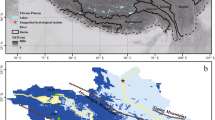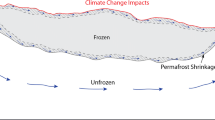Abstract
A quantitative estimate is given to the hypothesis, explaining the paleogeographic data on the extremely high water abundance in rivers in the Caspian Basin in the period when the Late Khvalynian Transgression was forming, by postglacial permafrost in this basin, which could contribute to a decrease of soil infiltration and evapotranspiration, and an increase of river flow. The estimate was based on numerical experiments with a physical-mathematical ECOMAG model of Volga runoff formation. Two series of experiments were carried out to simulate deep soil freezing all over the territory of the present-day Volga basin. In these experiments, the process of seasonal thawing of frozen soils was described taking into account their thawing during the warm (summer–autumn) season and the formation of annual thawed layer (1); in the cases where there was no seasonal thawing, lower values of soil heat conductance were specified (2). If we assume that the climate conditions in the territory of the present-day Volga basin during the formation of the Late Khvalynian transgression were similar to those we see now, the increase in the water abundance in rivers compared with its present-day level can be partly attributed to the occurrence of postglacial permafrost in this basin. At the same time, the increase in the normal annual runoff due to seasonal thawing of permafrost is about 20% (the runoff coefficient increases from 0.36 to 0.44) and does not agree with the huge inflow (>450 km3/year) estimated by paleogeographic data. Under the current climate conditions, an inflow 85% greater than the estimated value (an increase in the runoff coefficient up to 0.67) can be formed in the absence of seasonal thawing of the frozen catchment, i.e., at air temperature lower than its current value.









Similar content being viewed by others
REFERENCES
Vodnyi balans i kolebaniya urovnya Kaspiiskogo morya: modelirovanie i prognoz (Water Budget and Level Variations in the Caspian Sea: Simulation and Forecasting), Nesterov, E.S, Ed., Moscow: Triada, 2016.
Georgiadi A.G., Koronkevich N.I., Milyukova I.P., Kashutina E.A., Barabanova E.A. Sovremennye i stsenarnye izmeneniya rechnogo stoka v basseinakh krupneishikh rek Rossii (Modern and Scenario Changes of River Runoff in the Basins of Largest Russian Rivers), Pt. 2, Basseiny rek Volgi i Dona (Volga and Don Basins), Moscow: MAKS Press, 2014.
Georgievskii, V.Yu. and Shalygin, A.L., Hydrological regime and water resources, Metody otsenki izmeneniya klimata dlya fizicheskikh i biologicheskikh system (Methods for Assessing Climate Changes for Physical and Biological Systems), Semenov, S.M., Ed., Moscow: NITs Planeta, 2012.
Golitsyn, G.S. and Panin, G.N., On water balance and current level variations in the Caspian Sea, Meteorol. Gidrol., 1989, no. 1, pp. 57–64.
Kalugin, A.S., A unified hydrological model of the Volga basin, Trudy Vseros. nauch. konf. “Nauchnye problemy ozdorovleniya rossiiskikh rek i puti ikh resheniya” (Proc. Russian Sci. Conf. “Scientific Problems of Environmental Sanitation and Ways of Their Solution”), Moscow: Studiya F1, 2019, pp. 155–160.
Kuchment, L.S., Rechnoi stok (genezis, modelirovanie, predvychislenie) (River Runoff: Genesis, Simulation, Precomputation), Moscow, 2008.
Mikhailov, V.N. and Povalishnikova, E.S., Once again about the causes of Caspian Sea level variations in the XX century, Vestn. Mosk. Univ., Ser. 5, Geogr., 1998, no. 3, pp. 35–38.
Motovilov, Yu.G., Hydrological simulation of river basins at different spatial scales: 2. Test results, Water Resour., 2016, no. 5, pp. 743–753.
Motovilov, Yu.G. and Gel’fan, A.N., Modeli formirovaniya stoka v zadachakh gidrologii rechnykh basseinov (Runoff Formation Models in Problems of River Basin Hydrology), Moscow: Ross. Akad. Nauk, 2018.
Panin, A.V., Sidorchuk, A.Yu., and Chernov, A.V., Macrobends of rivers in ER and problems of paleohydrological reconstructions, Vodn. Resur., 1992, no. 4, pp. 93–97.
Sidorchuk, A.Yu., Borisova, O.K., and Panin, A.V., Late-Valdai river paleochannels in the Russian Plain, Izv. Akad. Nauk, Ser. Geogr., 2000, no. 6, pp. 73–78.
Sidorchuk, A.Yu. and Panin, A.V., Geomorphological approaches to evaluating river runoff in the geological past, Pap. 2, Hydraulic methods for retrodiction of discharges in paleorivers, Geomorfologiya, 2017, no. 2, pp. 3–13.
Sidorchuk, A.Yu., Panin, A.V., and Borisova, O.K., Geomorphological approaches to evaluating river runoff in the geological past, Pap. 5, Comparative analysis of the results obtained by different methods, Geomorfologiya, 2019, no. 1, pp. 66–79.
Sidorchuk, A.Yu., Panin, A.V., and Borisova, O.K., Climatic changes in river water flow on the southern megaslope of the East European Plain in the Late Glacial Period, Drevnie i sovremennye doliny i reki: istoriya formirovaniya, erozionnye i ruslovye protsessy (Ancient and Modern Valleys and Rivers: Formation History, Erosion and Channel Processes), Chalov, R.S., Ed., Volgograd: VGPU, 2010.
Sidorchuk, A.Yu., Panin, A.V., Borisova, O.K., and Eremenko, E.A., Geomorphological approaches to evaluating river runoff in the geological past, Pap. 3, Analysis of the structure of stream network, Geomorfologiya, 2018, no. 1, pp. 18–32.
Toropov, P.A. and Kislov, A.V., Modeling of variations in river runoff on the East European Plain under different climates of the past, Water Resour., 2006, no. 5, pp. 471–482.
Frolov, A.V., Modelirovanie mnogoletnikh kolebanii urovnya Kaspiiskogo morya: teoriya i prilozheniya (Modeling Long-Term Variations of Caspian Sea Level: Theory and Applications), Moscow: GEOS, 2003.
Yanina, T.A., Neopleistotsen Ponto-Kaspiya: biostratigrafiya, paleogeografiya, korrelyatsiya (Neopleistocene of the Ponto-Caspian: Biostratigraphy, Paleogeography, Correlation), Moscow: Mosk. Gos. Univ., 2012.
Aerts, J.C.J.H., Renssen, H., Ward, P.J., de Moel, H., Odada, E., Bouwer, L.M., and Goosse, H., Sensitivity of global river discharges under Holocene and future climate conditions, Geophys. Rev. Lett., 2006, vol. 33, p. L19401.
Arpe, K. and Leroy, S.A.G., The Caspian Sea level forced by the atmospheric circulation as observed and modeled, Quat. Int., 2007, vol. 173-174, pp. 144–152.
Elguindi, N. and Giorgi, F., Simulating multi-decadal variability of Caspian Sea level changes using regional climate model outputs, Clim. Dyn., 2005, vol. 26, pp. 167–181.
Gelfan, A., Kalugin, A., Krylenko, I., Nasonova, O., Gusev, Ye., and Kovalev, E., Does a successful comprehensive evaluation increase confidence in a hydrological model intended for climate impact assessment?, Clim. Change, 2020, vol. 163, pp. 1165–1185.
Gosling, S.N. and Arnell, N.W., Simulating current global river runoff with a global hydrological model: model revisions, validation and sensitivity analysis, Hydrol. Proc., 2010, vol. 25, no. 7, pp. 1129–1145.
Haddeland, I. and Heinke, J., Voß, F., Eisner, S., Chen, C., Hagemann, S., and Ludwig, F., Effects of climate model radiation, humidity and wind estimates on hydrological simulations, Hydrol. Earth Syst. Sci., 2012, vol. 16, pp. 305–318.
Joussaume, S. and Taylor, K., Status of the Paleoclimate Modeling Intercomparison Project (PMIP), Proc. First Int. AMIP Sci. Conf., Geneva, 1995, pp. 425–430.
Kalugin, A.S., The impact of climate change on surface, subsurface, and groundwater flow: a case study of the Oka River (European Russia), Water Resour., 2019, vol. 46, no. S2, pp. 31–S39.
Kislov, A.V., Panin, A., and Toropov, P., Current status and palaeostages of the Caspian Sea as a potential evaluation tool for climate model simulations, Quat. Int., 2014, vol. 345, pp. 48–55.
Kislov, A. and Toropov, P., East European river runoff and Black Sea and Caspian Sea level changes as simulated within the Paleoclimate Modeling Intercomparison Project, Quat. Int., 2007, vol. 167–168, pp. 40–48.
Krysanova, V., Donnelly, C., Gelfan, A., Gerten, D., Arheimer, B., Hattermann, F., and Kundzewicz, Z.W., How the performance of hydrological models relates to credibility of projections under climate change, Hydrol. Sci. J., 2018, vol. 63, no. 5, pp. 696–720.
Lougheed, B.C., Holocene climate and the Caspian Sea: a coupled climate, hydrological and sea level model approach, MSc thesis, Amsterdam: Vrije Univ. Amsterdam, 2006, 67 p.
Motovilov, Y.G., Gottschalk, L., Engeland, L., and Rodhe, A., Validation of a distributed hydrological model against spatial observation, Agric. For. Meteorol., 1999, vol. 98-99, pp. 257–277.
Renssen, H., Goosse, H., Fichefet, T., Brovkin, V., Driesschaert, E., and Wol, F., Simulating the Holocene climate evolution at northern high latitudes using a coupled atmosphere–sea ice–ocean–vegetation model, Clim. Dyn., 2005, vol. 24, pp. 23–43.
Renssen, H., Lougheed, B.C., Aerts, J.C.J.H., de Moel, H., Ward, P.J., and Kwadijk, J.C.J., Simulating long-term Caspian Sea level changes: the impact of Holocene and future climate conditions, Earth Planet. Sci. Lett., 2007, vol. 261, pp. 685–693.
Rychagov, G.I., Holocene oscillations of the Caspian Sea and forecasts based on palaeogeographical reconstructions, Quat. Int., 1997, vol. 41-42, pp. 167–172.
Panin, A.V., Astakhov, V.I., Lotsari, E., Komatsu, G., Lang, J., and Winsemann, J., Middle and Late Quaternary glacial lake-outburst floods, drainage diversions and reorganization of fluvial systems in Northwestern Eurasia, Earth-Sci. Rev., 2020, vol. 201, p. 103069.
Panin, A., and Matlakhova, E., Fluvial chronology in the East European plain over the last 20 ka and its palaeohydrological implications, Catena, 2015, vol. 130, pp. 46–61.
Schmied, H.M., Eisner, S., Franz, D., Wattenbach, M., Portmann, F.T., Flörke, M., and Döll, P., Sensitivity of simulated global-scale freshwater fluxes and storages to input data, hydrological model structure, human water use and calibration, Hydrol. Earth Syst. Sci., 2014, vol. 18, pp. 3511–3538.
Sidorchuk, A., Panin, A., and Borisova, O., Morphology of river channels and surface runoff in the Volga River basin (East European Plain) during the late glacial period, Geomorphology, 2009, vol. 113, nos. 3-4, pp. 137–157.
Sima, A., Kageyama, M., Rousseau, D.D., Ramstein, G., Balkanski, Y., Antoine, P., and Hatt, C., Modeling dust emission response to North Atlantic millennial scale climate variations from the perspective of East European MIS 3 loess deposits, Clim. Past, 2013, vol. 9, pp. 1385–1402.
Tudryn, A., Leroy, S.A.G., Toucanne, S., Gibert-Brunet, G., Tucholka, P., Lavrushin, Y.A., Dufaure, O., Miska, S., and Bayon, G., The Ponto-Caspian basin as a final trap for southeastern Scandinavian ice-sheet meltwater, Quat. Sci. Rev., 2016, vol. 148, pp. 29–43.
Turuncoglu, U.U., Giuliani, G., Elguindi, N., and Giorgi, F., Modelling the Caspian Sea and its catchment area using a coupled regional atmosphere–ocean model (RegCM4-ROMS): model design and preliminary results, Geosci. Model Dev., 2013, vol. 6, pp. 283–299.
Veldkamp, E., Zhao, F., Ward, P.J., de Moel, H., Aerts, J.C.J.H., Portmann, H.M., Masaki, Y., Pokhrel, Y., Liu, X., Satoh, Y., Gerten, D., Gosling, S.N., Zaherpour, J., and Wada, Y., Human impact parameterizations in global hydrological models improve estimates of monthly discharges and hydrological extremes: a multimodel validation study, Environ. Res. Lett., 2018, vol. 13, p. 055008.
Yanko-Hombach, V. and Kislov, A., Late Pleistocene and Holocene sea-level dynamics in the Caspian and Black seas: Data synthesis and paradoxical interpretations, Quat. Int., 2018, vol. 465, pp. 63–71.
Funding
The study was supported by the Russian Science Foundation (the results for the modern conditions of runoff formation in the Volga basin were obtained under project, 20-77-00077, the results for the conditions of additional freezing of soils were obtained under project 19-17-00215) and under subject 0147-2019-0001, Governmental Order to WPI RAS (preparation of data for runoff formation model).
Author information
Authors and Affiliations
Corresponding author
Additional information
Translated by G. Krichevets
Rights and permissions
About this article
Cite this article
Gelfan, A.N., Kalugin, A.S. Permafrost in the Caspian Basin as a Possible Trigger of the Late Khvalynian Transgression: Testing Hypothesis Using a Hydrological Model. Water Resour 48, 831–843 (2021). https://doi.org/10.1134/S0097807821060063
Received:
Revised:
Accepted:
Published:
Issue Date:
DOI: https://doi.org/10.1134/S0097807821060063




